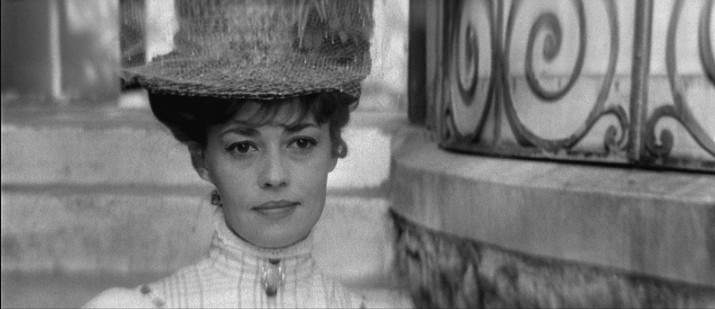
One of the most influential films of the New Wave is Francois Truffaut’s Jules et Jim (1962). The film follows the destruction of a bond between two men through the woman who comes between them. Truffaut captures the love triad between Jules, Jim and Catherine from the turn of the 20th century through a world war and into the roaring twenties. The time frame parallels the change in culture with the fluctuation of love between the characters. Through the period piece Truffaut depicts the dangers of a down to earth femme fetale, Catharine, through her transformation into the modern woman.
Jules is a foreigner in Paris, an Austrian, and a man very much naive about the vices of women. His best friend on the other hand Jim is a Parisian, a flagrant womanizer who always seems to return to his faithful mistress Gilberte. Jules and Jim are drawn to Catharine initially not for her complete self, but because of her resemblance to a statue they are fixated with. She had the same enigmatic smile as the statue. Jules marks her as the woman he wants to spend the rest of his life with, going to the extent of warning Jim off in the famous line: “Not this one, Jim”. When Jules discusses the prospect of marriage, Jim sees the reality and warns: “I’m afraid she’ll never be happy on this earth. She’s a vision for all, perhaps not meant for any one man alone”. Jim suppresses his attraction to Catherine out of difference to Jules. Shortly after Jules marries Catharine, the First World War breaks out and separates the two friends for the time being.
Catharine refuses to live life by the rules. She dresses in drag wearing the clothes of a boy with a grease moustache on an outing with Jules and Jim. They race across a bridge; however, Catharine cheats to get a head start. Later when she hears Jules talking to Jim about traditional marital expectations that the woman’s fidelity is more crucial than the mans, Catharine protests by leaping into a canal fully robed. Her impulsive act is foolhardy and irrational. She never explains her actions when Jules and Jim fish her out. The reference in the dialogue about marital roles foreshadows how Jules will be forced to eat his own words later when he is cuckolded over and over again by Catharine’s whims.
Obsessed with vengeance, Catharine believe she must get “even” with every perceived injustice done to her. She does not take into consideration whether it was intentional or circumstantial injury, but seeks to punish her perceived persecutor nevertheless. Catharine later justifies herself to Jim when he visits their Chalet on the Rhine after the war that because Jules’ mother had offended her at their wedding she cheated on her wedding night with an old flame in order to be even with Jules.
Catharine’s selfishness fuels her agency. She dominates her marriage with Jules. He tolerates her every whim with patience lest he loose her completely. When Jim visits their Chalet, Jules even offers Catharine to him in marriage so that she will not be “taken away from him” by another man. The love triad is not a permanent solution, because Jim finds himself jealous of his friend when Catharine chooses to seduce Jules on whim and Catharine grows disillusioned when she cannot have Jim’s child. She becomes self-destructive spurning Jim in the fear that one day he will leave her for a younger woman now she is no longer young.
In the late 1920s, Jules and Catharine move back to France with their daughter Sabine and by that time Jim has let Catharine go deciding to marry the woman who has waited for him all along, Gilberte. Catharine cannot handle loosing Jim and soon grows restless. Jules tells Jim that she is depressed and has purchased a revolver. One day Catharine drives her car off the road around the trees outside Jim’ apartment. She lures him to her bedroom but when Jim refuses to sleep with her. Instead he points out to her the sacrifices he made for her that she was unwilling to make in return, but in the end Catharine cannot see beyond herself. She asks him “What about me?” cries and then turns on Jim pulling her revolver on him. Jim barely escapes by jumping from a window.
A few months later Catherine triumphs when Jules, Jim and her have a chance encounter at a movie theater. Afterwards Catharine lures Jim into her car on the pretext of “having something to tell him” and then coyly tells her husband to “watch them closely”. Jules watches and to his horror Catharine drives her car quite intentionally off a broken bridge taking Jim’s life along with her own. In that act Catharine defines the femme fetale – the fatal female.
As a liberated woman who does as she pleases Catharine compromises her family and the friendship between Jules and Jim. As time passes and the dresses get shorter and shorter, Catherine grows bolder and bolder. She wraps her lingerie in a package before Jules and Jim before leaving them to openly have an affair with another man. Perhaps Truffaut is attempting to illustrate the dangers of gender role reversals. In their marriage Catharine could arguably be the one who wears the pants. She drives the car and is she who has numerous infidelities. Truffaut defines a down to earth yet very volatile femme fetale in his characterization of Catherine in Jules et Jim.
No comments:
Post a Comment